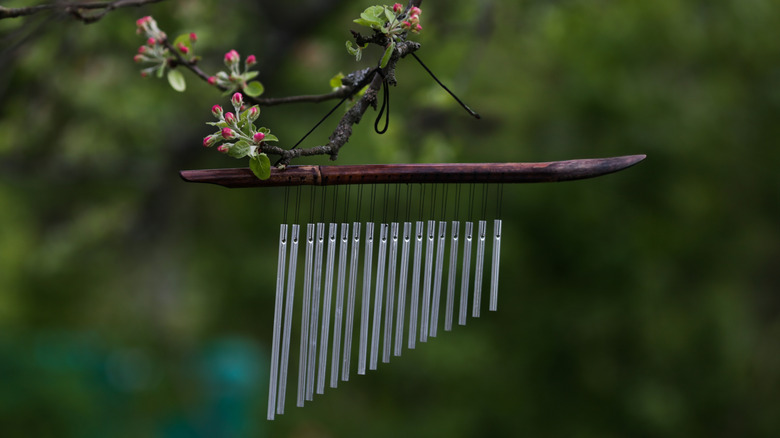All The Benefits Of Having A Sensory Garden In Your Backyard
Whether it features brilliant blooms, clever landscaping, or striking foliage, a garden is a feast for the eyes — and possibly also a literal feast in the case of vegetable gardens. But what about the other three senses? To stimulate all five, you might consider designing a sensory garden for your yard.
Beyond solely aesthetic or edible appeal, sensory gardens are meant to provide visitors with a deeper and more engaged experience by offering opportunities to smell, touch, and listen. This may include plants with textured leaves or other interesting tactile sensations, plants that release intriguing aromas when bruised, auditory stimuli like moving water or trees whose leaves make distinctive sounds when they blow in the wind, and more. To get an impression of the full breadth of experiences a sensory garden can provide, you might want to inquire at your local botanical garden or arboretum for inspiration — chances are, they have a section devoted to teasing the senses.
There are a number of potential therapeutic benefits to visiting a sensory garden, including increased neuroplasticity, improved memory recall, and better sleep health. This can be especially valuable for children, people living with trauma and mental health struggles, disabled people, blind or low vision people, neurodivergent individuals, and elderly people living with dementia or Alzheimer's. Additionally, blind/low vision or deaf/hard of hearing gardeners and garden visitors might particularly enjoy an inclusive sensory experience.
Choosing your plants for a sensory garden
One way to begin selecting plants is to write down each sense you're hoping to tantalize and start listing desired experiences beneath each — for example, "fuzzy" or "spicy." Think about times you've been struck by different fragrances of roses, or you've touched a leaf that caught your attention for reasons you couldn't quite describe. Keep in mind that because this type of garden should be enjoyed with more than just your eyes, plant selections should be non-toxic and safe — nobody wants an encounter that ends with hydrocortisone cream!
Try to create layers of different experiences. Perhaps you could add a combination of plants that smell stronger and plants whose scents are faint and need closer inspection to pick up. Consider plants with multifaceted potential, such as wild thyme — a groundcover hardy in USDA Hardiness Zones 4 through 9 whose purple blooms draw the eye while leaves crushed underfoot release an aroma. Echinacea, hardy in zones 3 to 8, can stimulate the eyes with its blossoms, the fingers with its spiny seeds and hairy stem, and the ears when finches feed on the seeds.
Lamb's ear and Irish moss are excellent touch-focused choices, both hardy in zones 4 through 8. Mint is also hardy in zones 4 through 9 and can tempt the tongue. When bruised between the fingers, oregano exercises both smell and touch, and is suited to zones 3 to 10. False indigo, which is hardy in zones 3 to 9, produces seed pods that make a rattling sound.
Sensory garden hardscaping and design
Nearly as important as plant selections, the design of your sensory garden matters. Hardscaping — the non-living part of the landscape like ornamental boulders and stone or wood retaining walls — can provide additional visual and tactile engagement. Benches with textured surfaces serve as both an invitation to linger and to touch. You might even consider building a bench using a tree stump. Water features and wind chimes can provide soothing soundscapes. Even a path can provide additional sensation if it's made of stepping stones, sand, or flagstones.
Because a sensory garden is meant to be inclusive and accessible, you need to consider how visitors move through your garden and how easy it is to actually come into contact with all of its stimuli. There's no point in having touchable plants if it's impossible to reach them! Raised beds and hanging baskets that can be lowered or elevated are a great way to ensure that plants are within reach.
Designing for accessibility makes the garden purely yours and tailored to your specific needs. For example, individuals who are visually impaired and use a cane to get around would benefit from a wide, flat path between beds with clearly delineated edging in brick or stone to ensure a safer, more calming experience. Or if you are easily overstimulated by powerful aromas, you can select plants with mild scents that you can enjoy at your own comfort level or place stronger-smelling plants further from the path so that they don't overwhelm you.


